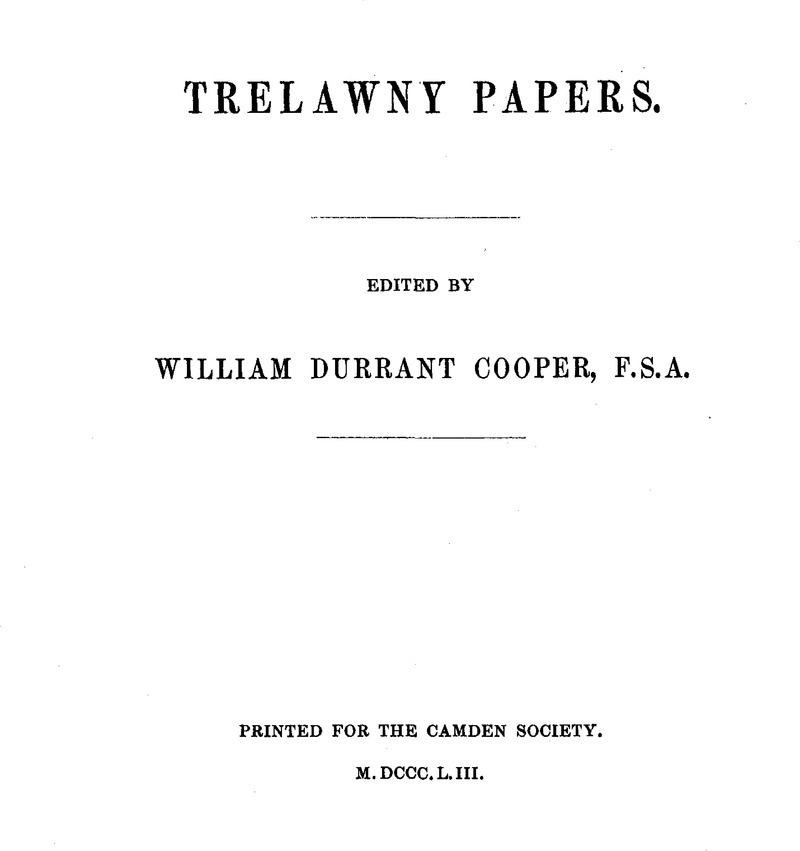No CrossRef data available.
Article contents
Trelawny Papers
Published online by Cambridge University Press: 25 March 2010
Abstract

- Type
- Other
- Information
- Camden Old Series , Volume 55: The Camden Miscellany, Volume the Second , December 1853 , pp. 3 - 23
- Copyright
- Copyright © Royal Historical Society 1853
References
“By Tre-, Pol-, and Pen-,
You shall know the Cornish men.”
Sir Jonathan Trelawny purchased Trelawny, near West Looe, in 1599. He was of Poole, near Liskeard. Carew, in his Survey of Cornwall, p. 117 (1602), says, “Poole houseth Sir Ionathan Trelawny, farre beneath his worth and calling… Poole standeth in Mynhinet (now Mehheniot) parish.”
page 4 note a Orig. in State Paper Off.—Domestic, 1686.
page 5 note a Hist, of Own Times, vol. iii. p. 186.
page 7 note a Donington Castle.
page 7 note b These complaints of Essex against Waller attained such a height that they could not be concealed from the Parliament.
page 8 note a See also Clarendon's Hist, of the Rebellion, book viii. vol. iv. p. 553.
page 9 note a Brentford.
page 10 note a This was Sir Bevil Grenville, who was killed at the battle of Lansdowne (5th July, 1643), where the Corniahmen did excellent service. In the Grenville Library is a volume of Oxford verses (1643) to his memory by William Cartwright and others, noticed by Mr. Bolton Corney in Notes and Queries, vol. i. p. 151. Sir Richard Grenville was his younger brother.
page 10 note b The original warrant from Col. John Digby, dated 1st March, 1642–3, is among the family papers.
page 14 note a Origihal in State Paper Office.—Domestic, 1686.
page 16 note a The draft is in the bishop's handwriting; the letter is in the State Paper Office.— Domestic, 1686.
page 16 note b Jonathan Rashleigh, esq. of Menabilly, M.P. for Powey in the parliaments from 1660 to 1690.
page 17 note a John Earl of Bath, who had been appointed at the Restoration in 1660.
page 17 note b State Paper Office.—Domestic, Various, No. 629, p. 371.
page 17 note c Nathaniel Lord Crewe, translated from the see of Oxford to Durham, Oct. 22, 1674.
page 17 note d These three bishops were all of James's appointment: Thomas Sprat, consecrated bishop of Rochester Nov. 2, 1684, Samuel Parker and Thomas Cartwright consecrated to the sees of Oxford and Chester respectively on the 17 Oct. 1686. See what Cartwright says of this Address in his Diary (printed for the Camden Society), pp. 50, 51, et seq. He was employed to win the assent of the bishops of Lincoln (Barlow) and Lichfleld (Wood), and after a long correspondence he effected his object. The Address of the former was presented to the King on the 30th June, and that of the latter on the 8th July. (Ibid, pp. 65, 66.)
page 19 note a William Jane, D.D. Regius Professor of Divinity in Oxford, was installed Dean of Gloucester 6th June, 1685.
page 20 note a This essay, if printed, was probably published anonymously, as the name of Ashleigh does not occur in Watt's Bibliotheca Britannica.
page 21 note a John Radcliffe, M.D. the celebrated physician.
page 22 note a Robert Harley, Earl of Oxford and Mortimer.
page 22 note b Sir Simon Harcourt.




